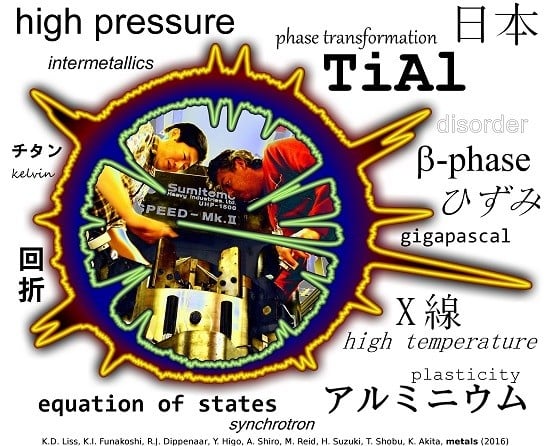Hydrostatic Compression Behavior and High-Pressure Stabilized β-Phase in γ-Based Titanium Aluminide Intermetallics
Abstract
:1. Introduction
2. Experimental Section
3. Results and Discussion
3.1. Pressure Loading at Room Temperature
3.1.1. Crystallographic Anisotropy, Disorder and Transformation Behavior
3.1.2. Volumetric Response and Equation of State
3.2. Temperature Dependence at High Pressure
4. Conclusions
Acknowledgments
Author Contributions
Conflicts of Interest
Abbreviations
| fcc | face-centered cubic |
| bcc | body-centered cubic |
| hcp | hexagonal close-packed |
| YAG | yttrium aluminium garnet, Y3Al5O12 |
| CCD | charged coupled device |
| SSD | solid-state detector |
| TNB | TiAl-Nb alloy |
References
- Lipsitt, H.A. Titanium Aluminides—An Overview. MRS Proc. 1984, 39, 351–364. [Google Scholar] [CrossRef]
- Kothari, K.; Radhakrishnan, R.; Wereley, N.M. Advances in gamma titanium aluminides and their manufacturing techniques. Prog. Aerosp. Sci. 2012, 55, 1–16. [Google Scholar] [CrossRef]
- Gupta, R.K.; Ramkumar, P. Titanium Aluminides for Metallic Thermal Protection System of Reusable Space Transportation Vehicle: A Review. Front. Aerosp. Eng. 2015, 4, 14–19. [Google Scholar] [CrossRef]
- Clemens, H.; Mayer, S. Intermetallic titanium aluminides in aerospace applications—Processing, microstructure and properties. Mater. High Temp. 2016. [Google Scholar] [CrossRef]
- Yang, R. Advances and challenges of TiAl base alloys. Acta Metall. Sin. 2015, 51, 129–147. [Google Scholar]
- Clemens, H.; Schloffer, M.; Schwaighofer, E.; Werner, R.; Gaitzenauer, A.; Rashkova, B.; Schmoelzer, T.; Pippan, R.; Mayer, S. Advanced β-Solidifying Titanium Aluminides—Development Status and Perspectives. In Symposium JJ—Intermetallic-Based Alloys—Science, Technology and Applications; Materials Research Society: Warrendale, PA, USA, 2013; Volume 1516, pp. 3–16. [Google Scholar]
- Liss, K.-D.; Schmoelzer, T.; Yan, K.; Reid, M.; Peel, M.; Dippenaar, R.; Clemens, H. In situ study of dynamic recrystallization and hot deformation behavior of a multiphase titanium aluminide alloy. J. Appl. Phys. 2009, 106, 113526:1–113526:6. [Google Scholar] [CrossRef]
- Appel, F.; Oehring, M.; Paul, J.D.H.; Klinkenberg, C.; Carneiro, T. Physical aspects of hot-working gamma-based titanium aluminides. Intermetallics 2004, 12, 791–802. [Google Scholar] [CrossRef]
- Erdely, P.; Schmoelzer, T.; Schwaighofer, E.; Clemens, H.; Staron, P.; Stark, A.; Liss, K.-D.; Mayer, S. In Situ Characterization Techniques Based on Synchrotron Radiation and Neutrons Applied for the Development of an Engineering Intermetallic Titanium Aluminide Alloy. Metals 2016, 6. [Google Scholar] [CrossRef]
- Clemens, H.; Mayer, S. Design, Processing, Microstructure, Properties, and Applications of Advanced Intermetallic TiAl Alloys. Adv. Eng. Mater. 2013, 15, 191–215. [Google Scholar] [CrossRef]
- Zhilyaev, A.P.; Langdon, T.G. Using high-pressure torsion for metal processing: Fundamentals and applications. Prog. Mater. Sci. 2008, 53, 893–979. [Google Scholar] [CrossRef]
- Yan, K.; Bhattacharyya, D.; Lian, Q.; Kabra, S.; Kawasaki, M.; Carr, D.G.; Callaghan, M.D.; Avdeev, M.; Li, H.; Wang, Y.; et al. Martensitic Phase Transformation and Deformation Behavior of Fe-Mn-C-Al Twinning-Induced Plasticity Steel during High-Pressure Torsion. Adv. Eng. Mater. 2014, 16, 927–932. [Google Scholar] [CrossRef]
- Edalati, K.; Toh, S.; Iwaoka, H.; Watanabe, M.; Horita, Z.; Kashioka, D.; Kishida, K.; Inui, H. Ultrahigh strength and high plasticity in TiAl intermetallics with bimodal grain structure and nanotwins. Scr. Mater. 2012, 67, 814–817. [Google Scholar] [CrossRef]
- Alhamidi, A.; Edalati, K.; Horita, Z. Production of nanograined intermetallics using high-pressure torsion. Mater. Res. 2013, 16, 672–678. [Google Scholar] [CrossRef]
- Krämer, L.; Kormout, K.S.; Setman, D.; Champion, Y.; Pippan, R. Production of Bulk Metallic Glasses by Severe Plastic Deformation. Metals 2015, 5, 720–729. [Google Scholar] [CrossRef]
- France-Métallurgie. Blog Archive China’s 80,000-Ton Press Forge Almost Ready for Use (US). Available online: http://www.france-metallurgie.com/index.php/2013/03/18/chinas-80000-ton-press-forge-almost-ready-for-use-us/ (accessed on 10 June 2016).
- Altan, T.; Semiatin, S.L. Feasibility of Using a Large Press (80,000–200,000 Ton) for Manufacturing Future Components on Army Systems; U.S. Army Tank-Automotive Command Research and Development Center: Warren, MI, USA, 1983. [Google Scholar]
- The Machines that Made the Jet Age /Boing Boing. Available online: http://boingboing.net/2012/02/13/machines.html (accessed on 10 June 2016).
- Huber, D.; Werner, R.; Clemens, H.; Stockinger, M. Influence of process parameter variation during thermo-mechanical processing of an intermetallic β-stabilized γ-TiAl based alloy. Mater. Charact. 2015, 109, 116–121. [Google Scholar] [CrossRef]
- Li, X.-S.; Wang, H.-Y.; Li, C.-Y.; Mi, G.-F.; Hu, Q.-K. Structural and Thermodynamic Properties of TiAl intermetallics under High Pressure. Commun. Theor. Phys. 2012, 57, 141–144. [Google Scholar] [CrossRef]
- Young, D.A. Phase Diagrams of the Elements; University of California Lawrence Livermore Laboratory: Livermore, CA, USA, 1975. [Google Scholar]
- Jayaraman, A.; Klement, W.; Kennedy, G.C. Solid-Solid Transitions in Titanium and Zirconium at High Pressures. Phys. Rev. 1963, 131, 644–649. [Google Scholar] [CrossRef]
- Bystrzanowski, S.; Bartels, A.; Stark, A.; Gerling, R.; Schimansky, F.-P.; Clemens, H. Evolution of microstructure and texture in Ti-46Al-9Nb sheet material during tensile flow at elevated temperatures. Intermetallics 2010, 18, 1046–1055. [Google Scholar] [CrossRef]
- Appel, F.; Brossmann, U.; Christoph, U.; Eggert, S.; Janschek, P.; Lorenz, U.; Müllauer, J.; Oehring, M.; Paul, J.D.H. Recent Progress in the Development of Gamma Titanium Aluminide Alloys. Adv. Eng. Mater. 2000, 2, 699–720. [Google Scholar] [CrossRef]
- Appel, F.; Oehring, M.; Wagner, R. Novel design concepts for gamma-base titanium aluminide alloys. Intermetallics 2000, 8, 1283–1312. [Google Scholar] [CrossRef]
- Appel, F. Recent Developments in the Design and Processing of Gamma-Based Titanium Aluminide Alloys. Mater. Sci. Forum 2003, 426–432, 91–98. [Google Scholar] [CrossRef]
- Bystrzanowski, S. Creep Behavior and Microstructure Stability of the Ti-46Al-9Nb Sheet Material; Shaker Verlag GmbH: Aachen, Germany, 2005. [Google Scholar]
- Gerling, R.; Clemens, H.; Schimansky, F.P. Powder Metallurgical Processing of Intermetallic Gamma Titanium Aluminides. Adv. Eng. Mater. 2004, 6, 23–38. [Google Scholar] [CrossRef]
- Chladil, H.F.; Clemens, H.; Leitner, H.; Bartels, A.; Gerling, R.; Schimansky, F.-P.; Kremmer, S. Phase Transformations in High Niobium and Carbon Containing γ-TiAl Based Alloys. Intermetallics 2006, 14, 1194–1198. [Google Scholar] [CrossRef]
- Chladil, H.F.; Clemens, H.; Zickler, G.A.; Takeyama, M.; Kozeschnik, E.; Bartels, A.; Buslaps, T.; Gerling, R.; Kremmer, S.; Yeoh, L.; et al. Experimental studies and thermodynamic simulation of phase transformations in high Nb containing gamma-TiAl based alloys. Int. J. Mater. Res. 2007, 98, 1131–1137. [Google Scholar] [CrossRef]
- Yeoh, L.A.; Liss, K.-D.; Bartels, A.; Chladil, H.; Avdeev, M.; Clemens, H.; Gerling, R.; Buslaps, T. In situ high-energy X-ray diffraction study and quantitative phase analysis in the alpha plus gamma phase field of titanium aluminides. Scr. Mater. 2007, 57, 1145–1148. [Google Scholar] [CrossRef]
- Pecker, S.; Eliezer, S.; Fisher, D.; Henis, Z.; Zinamon, Z. A multiphase equation of state of three solid phases, liquid, and gas for titanium. J. Appl. Phys. 2005, 98, 043516:1–043516:12. [Google Scholar] [CrossRef]
- Greene, R.G.; Luo, H.; Ruoff, A.L. Al as a Simple Solid: High Pressure Study to 220 GPa (2.2 Mbar). Phys. Rev. Lett. 1994, 73, 2075–2078. [Google Scholar] [CrossRef] [PubMed]
- Quantum Beam Science—An Open Access Journal from MDPI; Rittman, M.; Liss, K.-D. (Eds.) MDPI: Basel, Switzerland, 2016.
- Shull, R.D.; Cline, J.P. High Temperature X-ray Diffractometry of Ti-Al Alloys. In Materials Chemistry at High Temperatures; Hastie, J.W., Ed.; Humana Press: Totowa, NJ, USA, 1990; pp. 95–117. [Google Scholar]
- Liss, K.-D.; Bartels, A.; Clemens, H.; Bystrzanowski, S.; Stark, A.; Buslaps, T.; Schimansky, F.-P.; Gerling, R.; Scheu, C.; Schreyer, A. Recrystallization and phase transitions in a gamma-TiAl-based alloy as observed by ex situ and in situ high-energy X-ray diffraction. Acta Mater. 2006, 54, 3721–3735. [Google Scholar] [CrossRef]
- Liss, K.-D.; Bartels, A.; Schreyer, A.; Clemens, H. High-energy X-rays: A tool for advanced bulk investigations in materials science and physics. Textures Microstruct. 2003, 35, 219–252. [Google Scholar] [CrossRef]
- Liss, K.-D. In situ diffraction studies related to thermo-mechanical processes. In Proceedings of the ICCE-23: Annual International Conference on Composites and Nano-Engineering, Chengdu, China, 12–18 July 2015.
- Liss, K.-D.; Yan, K. Thermo-mechanical processing in a synchrotron beam. Mater. Sci. Eng. A 2010, 528, 11–27. [Google Scholar] [CrossRef]
- Watson, I.J.; Liss, K.-D.; Clemens, H.; Wallgram, W.; Schmoelzer, T.; Hansen, T.C.; Reid, M. In Situ Characterization of a Nb and Mo Containing gamma-TiAl Based Alloy Using Neutron Diffraction and High-Temperature Microscopy. Adv. Eng. Mater. 2009, 11, 932–937. [Google Scholar] [CrossRef]
- Kabra, S.; Yan, K.; Mayer, S.; Schmoelzer, T.; Reid, M.; Dippenaar, R.; Clemens, H.; Liss, K.-D. Phase transition and ordering behavior of ternary Ti-Al-Mo alloys using in situ neutron diffraction. Int. J. Mater. Res. 2011, 102, 697–702. [Google Scholar] [CrossRef]
- Chen, B.; Lin, J.-F.; Chen, J.; Zhang, H.; Zeng, Q. Synchrotron-based High Pressure Research in Materials Science. MRS Bull. 2016, 41, 473–478. [Google Scholar] [CrossRef]
- Liss, K.-D.; Chen, K. Frontiers of synchrotron research in materials science. MRS Bull. 2016, 41, 435–441. [Google Scholar] [CrossRef]
- Errandonea, D. Transition metals: Can metals be a liquid glass? Nat. Mater. 2009, 8, 170–171. [Google Scholar] [CrossRef] [PubMed]
- Utsumi, W.; Funakoshi, K.; Urakawa, S.; Yamakata, M.; Tsuji, K.; Konishi, H.; Shimomura, O. SPring-8 Beamlines for High Pressure Science with Multi-Anvil Apparatus. Rev. High Press. Sci. Technol. 1998, 7, 1484–1486. [Google Scholar] [CrossRef]
- Utsumi, W.; Funakoshi, K.; Katayama, Y.; Yamakata, M.; Okada, T.; Shimomura, O. High-pressure science with a multi-anvil apparatus at SPring-8. J. Phys. Condens. Matter 2002, 14. [Google Scholar] [CrossRef]
- Hattori, T.; Saitoh, H.; Kaneko, H.; Okajima, Y.; Aoki, K.; Utsumi, W. Does Bulk Metallic Glass of Elemental Zr and Ti Exist? Phys. Rev. Lett. 2006, 96. [Google Scholar] [CrossRef] [PubMed]
- Errandonea, D.; Meng, Y.; Somayazulu, M.; Häusermann, D. Pressure-induced transition in titanium metal: A systematic study of the effects of uniaxial stress. Phys. B Condens. Matter 2005, 355, 116–125. [Google Scholar] [CrossRef]
- Tange, Y.; Higo, Y. BL04B1: In Situ Observation of High Pressure Phase Change of Simple Material; SPring-8, Asia Oceania Forum for Synchrotron Radiation Research: Kouto, Japan, 2007. [Google Scholar]
- Katsura, T.; Funakoshi, K.; Kubo, A.; Nishiyama, N.; Tange, Y.; Sueda, Y.; Kubo, T.; Utsumi, W. A large-volume high-pressure and high-temperature apparatus for in situ X-ray observation, ‘SPEED-Mk.II’. Phys. Earth Planet. Int. 2004, 143–144, 497–506. [Google Scholar] [CrossRef]
- Speziale, S.; Zha, C.-S.; Duffy, T.S.; Hemley, R.J.; Mao, H. Quasi-hydrostatic compression of magnesium oxide to 52 GPa: Implications for the pressure-volume-temperature equation of state. J. Geophys. Res. Solid Earth 2001, 106, 515–528. [Google Scholar] [CrossRef]
- Shim, S.-H.; Duffy, T.S.; Takemura, K. Equation of state of gold and its application to the phase boundaries near 660 km depth in Earth’s mantle. Earth Planet. Sci. Lett. 2002, 203, 729–739. [Google Scholar] [CrossRef]
- Seto, Y.; Nishio-Hamane, D.; Nagai, T.; N. Sata, N. Development of a software suite on X-ray diffraction experiments. Rev. High Pressure Sci. Technol. 2010, 20, 269–276. [Google Scholar] [CrossRef]
- Lutterotti, L. Total pattern fitting for the combined size-strain-stress-texture determination in thin film diffraction. Nucl. Instrum. Methods Phys. Res. Sect. B 2010, 268, 334–340. [Google Scholar] [CrossRef]
- Zhang, J.; Zhao, Y.; Hixson, R.S.; Gray, G.T.; Wang, L.; Utsumi, W.; Saito, H.; Hattori, T. Thermal equations of state for titanium obtained by high pressure/temperature diffraction studies. Phys. Rev. B 2008, 78, 054119:1–054119:7. [Google Scholar] [CrossRef]
- Titanium-Card No 44-1294; Joint Committee on Powder Diffraction Standards (JCPDS)—International Center for Diffraction Data (ICDD): Washington, DC, USA, 1999.
- Liss, K.-D.; Whitfield, R.E.; Xu, W.; Buslaps, T.; Yeoh, L.A.; Wu, X.; Zhang, D.; Xia, K. In situ synchrotron high-energy X-ray diffraction analysis on phase transformations in Ti-Al alloys processed by equal-channel angular pressing. J. Synchrotron Radiat. 2009, 16, 825–834. [Google Scholar] [CrossRef] [PubMed]
- Yan, K.; Carr, D.G.; Kabra, S.; Reid, M.; Studer, A.; Harrison, R.P.; Dippenaar, R.; Liss, K.-D. In Situ Characterization of Lattice Structure Evolution during Phase Transformation of Zr-2.5Nb. Adv. Eng. Mater. 2011, 13, 882–886. [Google Scholar] [CrossRef]
- Dubrovinskaia, N.A.; Vennström, M.; Abrikosov, I.A.; Ahuja, R.; Ravindran, P.; Andersson, Y.; Eriksson, O.; Dmitriev, V.; Dubrovinsky, L.S. Absence of a pressure-induced structural phase transition in Ti3Al up to 25 GPa. Phys. Rev. B 2000, 63, 024106:1–024106:5. [Google Scholar] [CrossRef]
- Asta, M.; de Fontaine, D.; van Schilfgaarde, M. First-principles study of phase stability of Ti-Al intermetallic compounds. J. Mater. Res. 1993, 8, 2554–2568. [Google Scholar] [CrossRef]
- Ghosh, G.; Asta, M. First-principles calculation of structural energetics of Al-TM (TM = Ti, Zr, Hf) intermetallics. Acta Mater. 2005, 53, 3225–3252. [Google Scholar] [CrossRef]
- Liss, K.-D.; Stark, A.; Bartels, A.; Clemens, H.; Buslaps, T.; Phelan, D.; Yeoh, L.A. Directional atomic rearrangements during transformations between the alpha- and gamma-phases in titanium aluminides. Adv. Eng. Mater. 2008, 10, 389–392. [Google Scholar] [CrossRef]
- Liss, K.-D.; Bartels, A.; Clemens, H.; Stark, A.; Buslaps, T.; Phelan, D.; Yeoh, L.A. In situ characterization of phase transformations and microstructure evolution in a gamma-TiAl based alloy. In Structural Aluminides for Elevated Temperature Applications; Kim, Y.-W., Morris, D., Yang, R., Leyens, C., Eds.; TMS (The Minerals, Metals & Materials Society): Warrendale, PA, USA, 2008; pp. 137–144. [Google Scholar]
- Cha, L.; Scheu, C.; Clemens, H.; Chladil, H.F.; Dehm, G.; Gerling, R.; Bartels, A. Nanometer-scaled lamellar microstructures in Ti-45Al-7.5Nb-(0; 0.5)C alloys and their influence on hardness. Intermetallics 2008, 16, 868–875. [Google Scholar] [CrossRef]
- Srinivasarao, B.; Zhilyaev, A.P.; Muñoz-Moreno, R.; Pérez-Prado, M.T. Effect of high pressure torsion on the microstructure evolution of a gamma Ti-45Al-2Nb-2Mn-0.8 vol. % TiB2 alloy. J. Mater. Sci., 2013, 48, 4599–4605. [Google Scholar] [CrossRef]
- Schuster, J.C.; Palm, M. Reassessment of the binary Aluminum-Titanium phase diagram. J. Phase Equilib. Diffus. 2006, 27, 255–277. [Google Scholar] [CrossRef]
- Anderson, D.L. Thermodynamics and Equations of State. In Theory of the Earth; Blackwell Scientific Publications: Boston, MA, USA, 1989; pp. 79–102. [Google Scholar]
- Singh, R.S. High pressure properties of metal using various equations of state. J. Integr. Sci. Technol. 2013, 1, 48–53. [Google Scholar]
- Birch, F. Elasticity and constitution of the Earth’s interior. J. Geophys. Res. 1952, 57, 227–286. [Google Scholar] [CrossRef]
- Murnaghan, F.D. The Compressibility of Media under Extreme Pressures. Proc. Natl. Acad. Sci. USA 1944, 30, 244–247. [Google Scholar] [CrossRef] [PubMed]
- Dubrovinsky, L.; Dubrovinskaia, N.; Bykova, E.; Bykov, M.; Prakapenka, V.; Prescher, C.; Glazyrin, K.; Liermann, H.; Hanfland, M.; Ekholm, M.; et al. The most incompressible metal osmium at static pressures above 750 gigapascals. Nature 2015, 525, 226–229. [Google Scholar] [CrossRef] [PubMed]
- Vinet, P.; Rose, J.H.; Ferrante, J.; Smith, J.R. Universal features of the equation of state of solids. J. Phys. Condens. Matter 1989, 1, 1941–1963. [Google Scholar] [CrossRef]
- Nishihara, Y.; Nakajima, Y.; Akashi, A.; Tsujino, N.; Takahashi, E.; Funakoshi, K.; Higo, Y. Isothermal compression of face-centered cubic iron. Am. Mineral. 2012, 97, 1417–1420. [Google Scholar] [CrossRef]
- Seto, Y. Seto’s Home Page. Available online: http://pmsl.planet.sci.kobe-u.ac.jp/~seto (accessed on 15 April 2016).
- Stark, A.; Rackel, M.; Tankoua, A.T.; Oehring, M.; Schell, N.; Lottermoser, L.; Schreyer, A.; Pyczak, F. In Situ High-Energy X-ray Diffraction during hot-forming of a multiphase TiAl Alloy. Metals 2015, 5, 2252–2265. [Google Scholar] [CrossRef]
- Stark, A.; Bartels, A.; Clemens, H.; Schimansky, F. On the Formation of Ordered ω-phase in High Nb Containing γ-TiAl Based Alloys. Adv. Eng. Mater. 2008, 10, 929–934. [Google Scholar] [CrossRef]
- Rackel, M.; Stark, A.; Gabrisch, H.; Schimansky, F.; Schell, N.; Schreyer, A.; Pyczak, F. In situ synchrotron radiation measurements of orthorhombic phase formation in an advanced TiAl alloy with modulated microstructure. MRS Proc. 2015, 1760. [Google Scholar] [CrossRef]
- Menon, E.S.K.; Fox, A.G.; Mahapatra, R. Accurate determination of the lattice parameters of γ-TiAl alloys. J. Mater. Sci. Lett. 1996, 15, 1231–1233. [Google Scholar] [CrossRef]
- Schmoelzer, T.; Liss, K.; Kirchlechner, C.; Mayer, S.; Stark, A.; Peel, M.; Clemens, H. An in situ high-energy X-ray diffraction study on the hot-deformation behavior of a β-phase containing TiAl alloy. Intermetallics 2013, 39, 25–33. [Google Scholar] [CrossRef]
- Petry, W.; Heiming, A.; Trampenau, J.; Alba, M.; Herzig, C.; Schober, H.R.; Vogl, G. Phonon dispersion of the bcc phase of group-IV metals. I. bcc titanium. Phys. Rev. B 1991, 43, 10933–10947. [Google Scholar] [CrossRef]
- Schmoelzer, T.; Liss, K.; Rester, M.; Yan, K.; Stark, A.; Reid, M.; Peel, M.; Clemens, H. Dynamic Recovery and Recrystallization during Hot-Working in an Advanced TiAl Alloy. Prakt. Metallogr. Pract. Metallogr. 2011, 48, 632–642. [Google Scholar] [CrossRef]
- Kabra, S.; Yan, K.; Carr, D.G.; Harrison, R.P.; Dippenaar, R.J.; Reid, M.; Liss, K. Defect dynamics in polycrystalline zirconium alloy probed in situ by primary extinction of neutron diffraction. J. Appl. Phys. 2013, 113, 063513:1–063513:8. [Google Scholar] [CrossRef]
- Hattori, T.; Sano-Furukawa, A.; Arima, H.; Komatsu, K.; Yamada, A.; Inamura, Y.; Nakatani, T.; Seto, Y.; Nagai, T.; Utsumi, W.; et al. Design and Performance of High-Pressure PLANET Beamline at Pulsed Neutron Source at J-PARC. Nucl. Instrum. Methods Phys. Res. Sect. Accel. Spectrom. Detect. Assoc. Equip. 2015, 780, 55–67. [Google Scholar] [CrossRef]
- Sano-Furukawa, A.; Hattori, T.; Arima, H.; Yamada, A.; Tabata, S.; Kondo, M.; Nakamura, A.; Kagi, H.; Yagi, T. Six-axis multi-anvil press for high-pressure, high-temperature neutron diffraction experiments. Rev. Sci. Instrum. 2014, 85, 113905:1–113905:8. [Google Scholar] [CrossRef] [PubMed]
- Funakoshi, K.; Higo, Y.; Nishihara, Y. High-pressure two-dimensional angle-dispersive X-ray diffraction measurement system using a Kawai-type multianvil press at SPring-8. J. Phys. Conf. Ser. 2010, 215. [Google Scholar] [CrossRef]

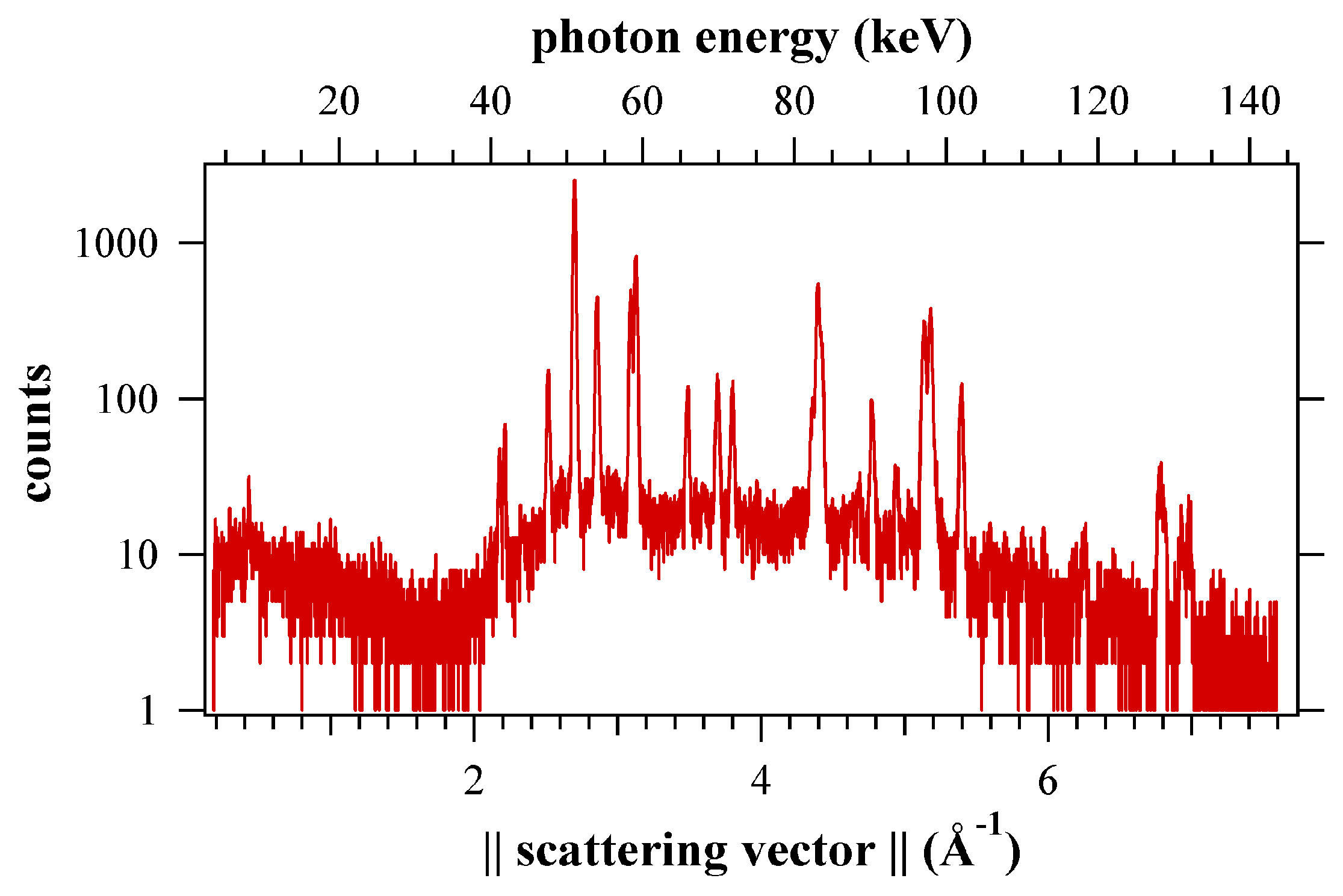
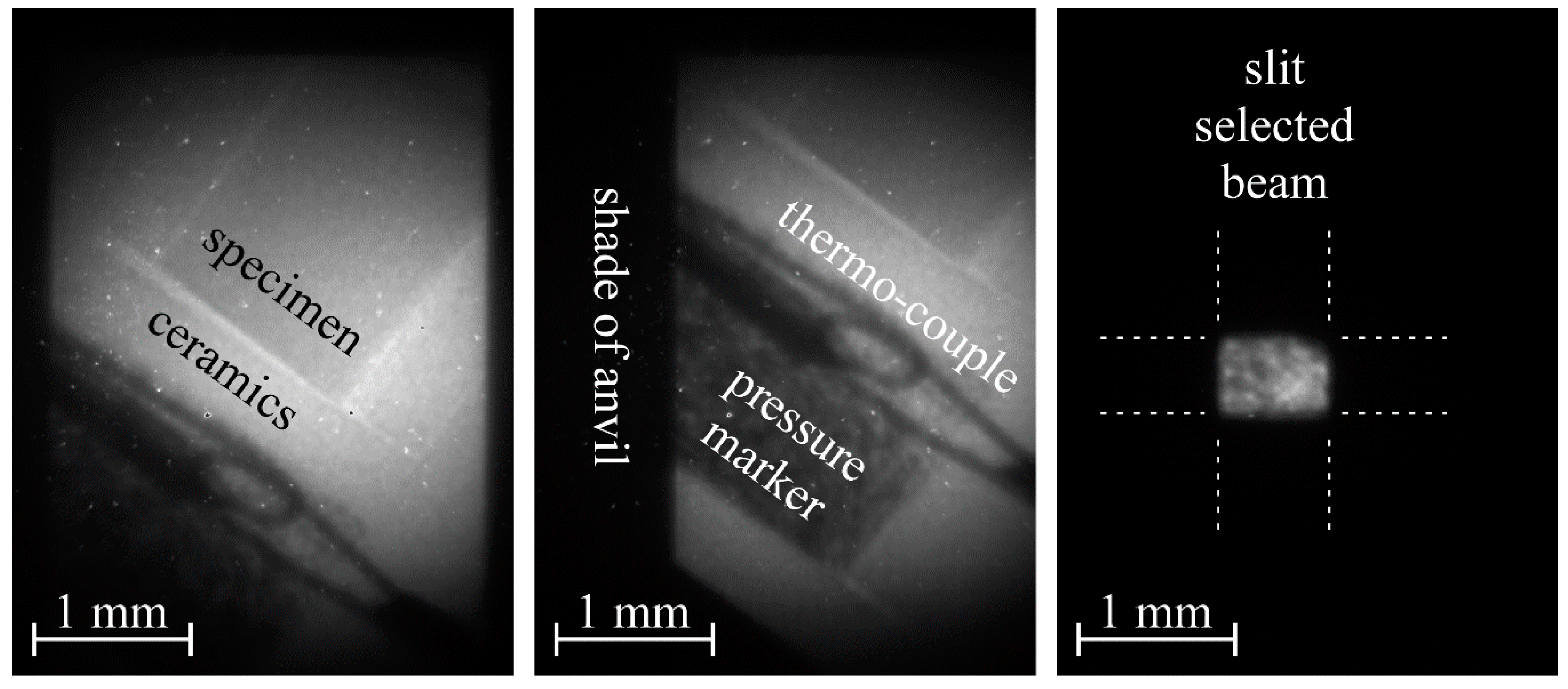

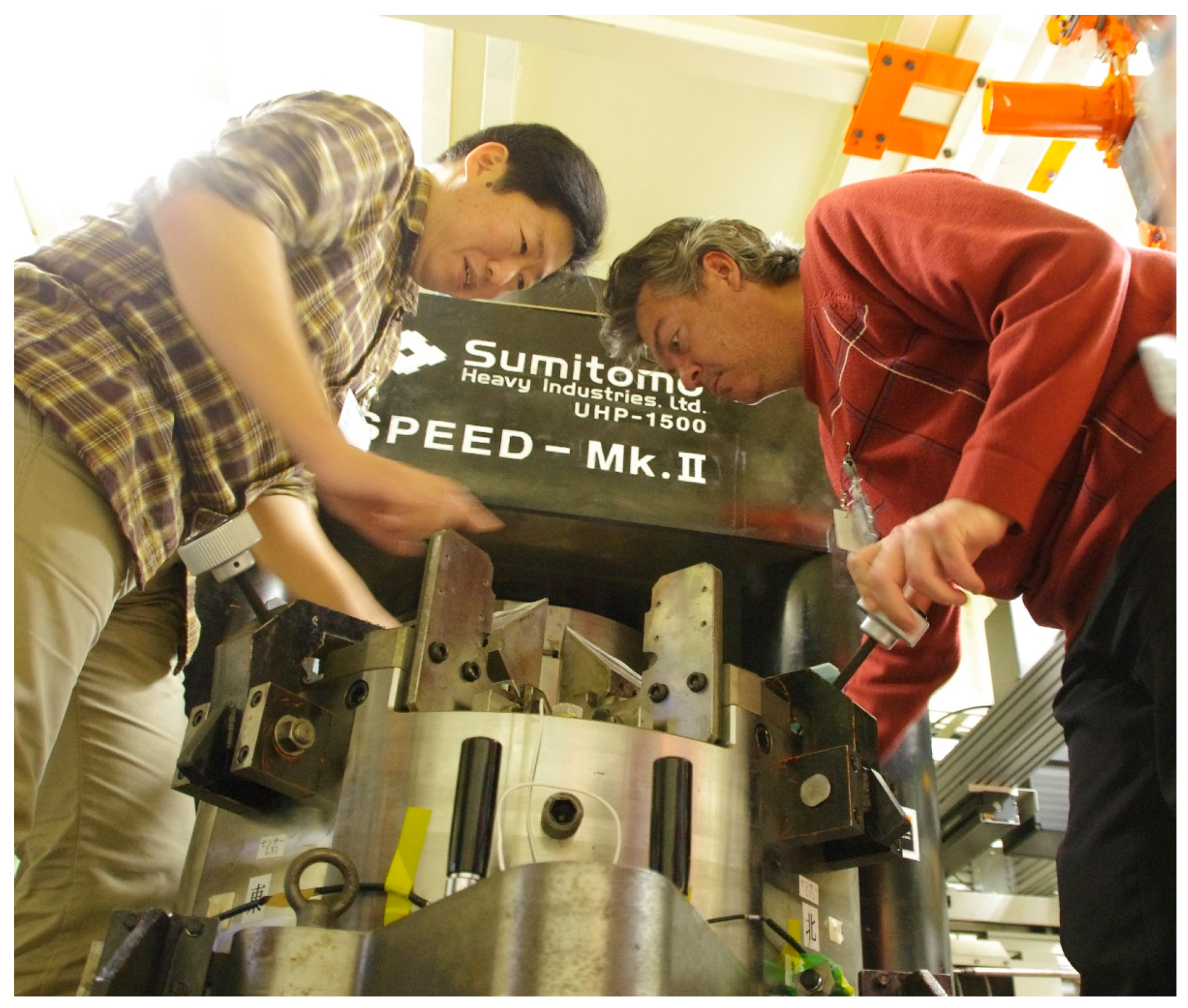
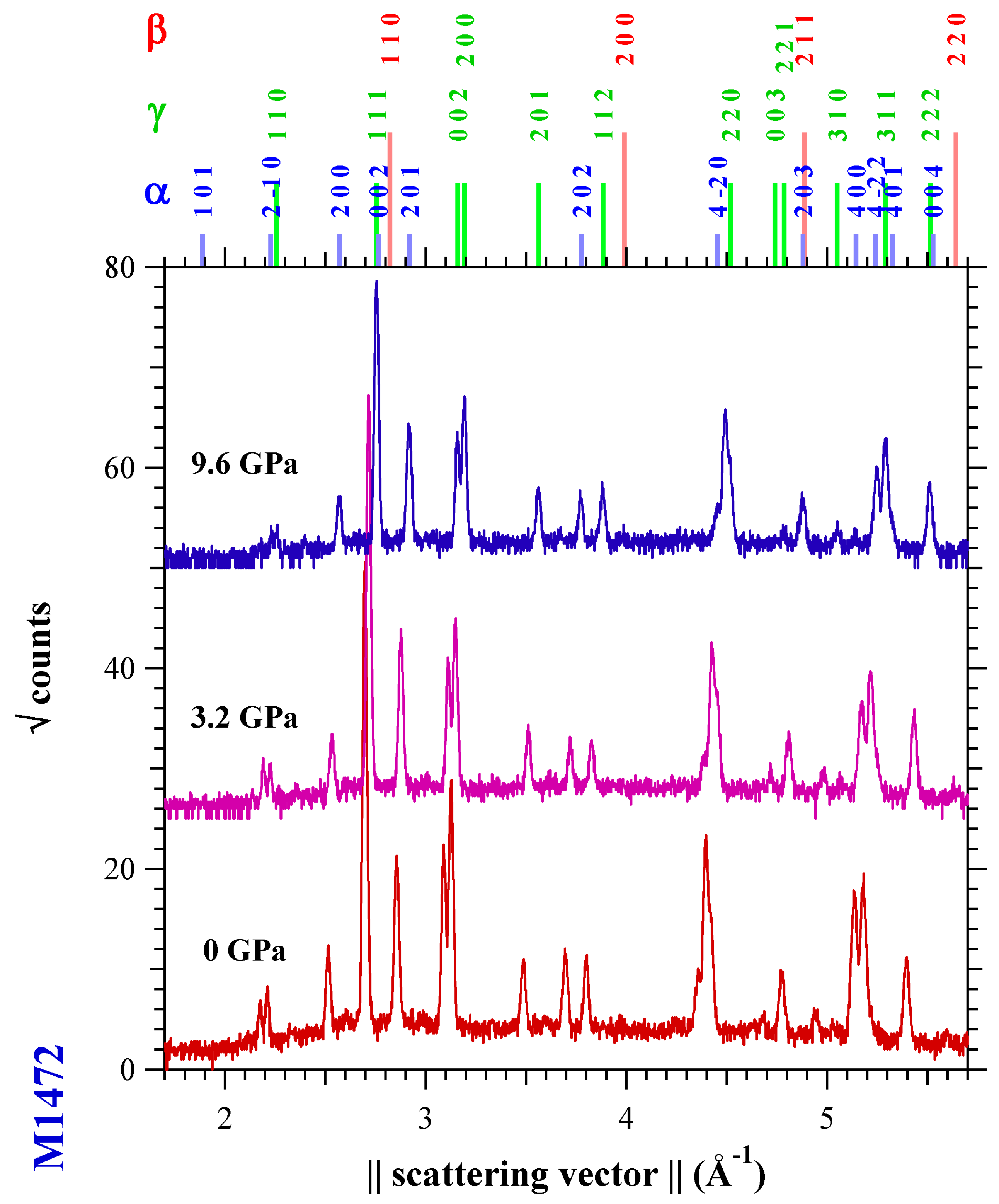
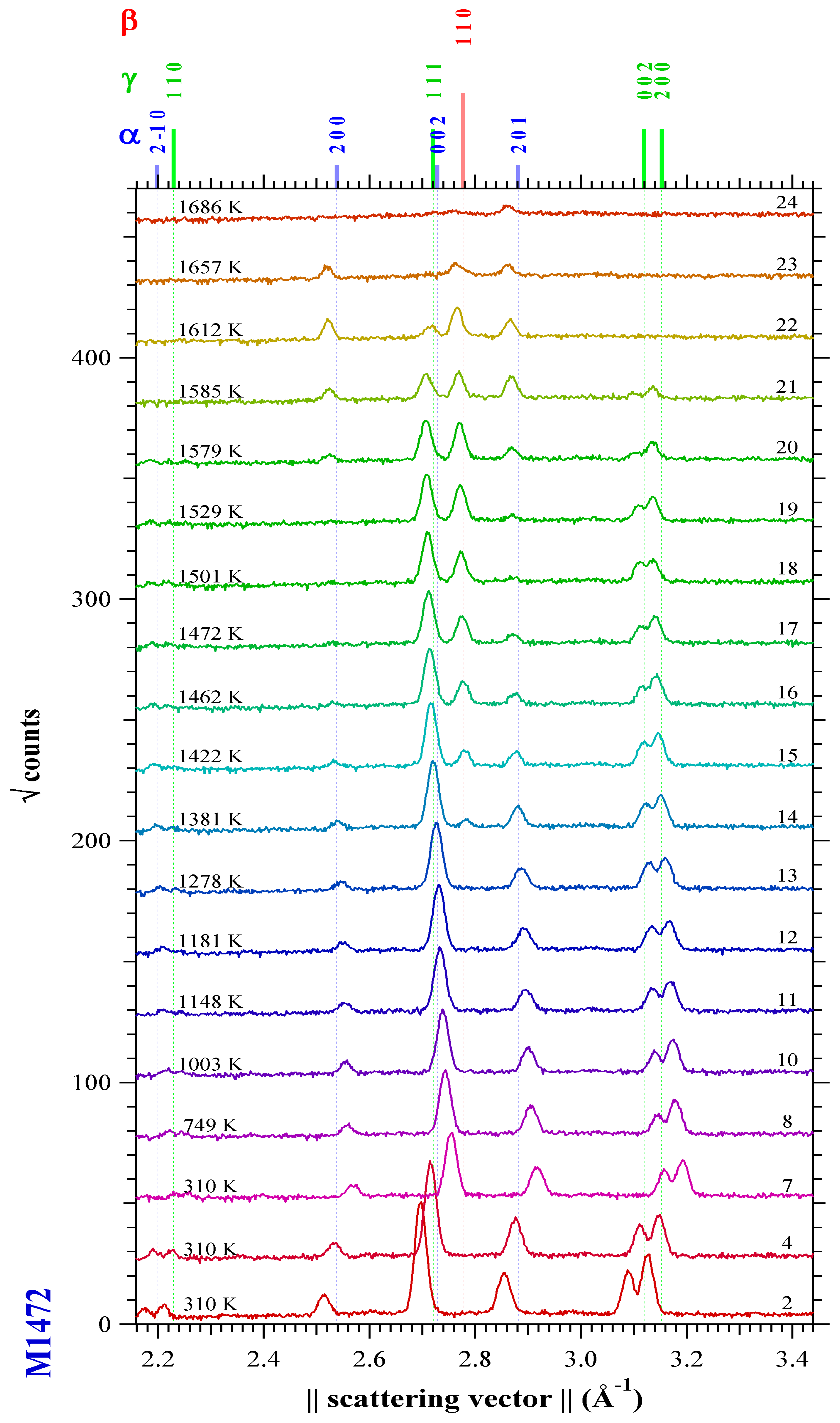
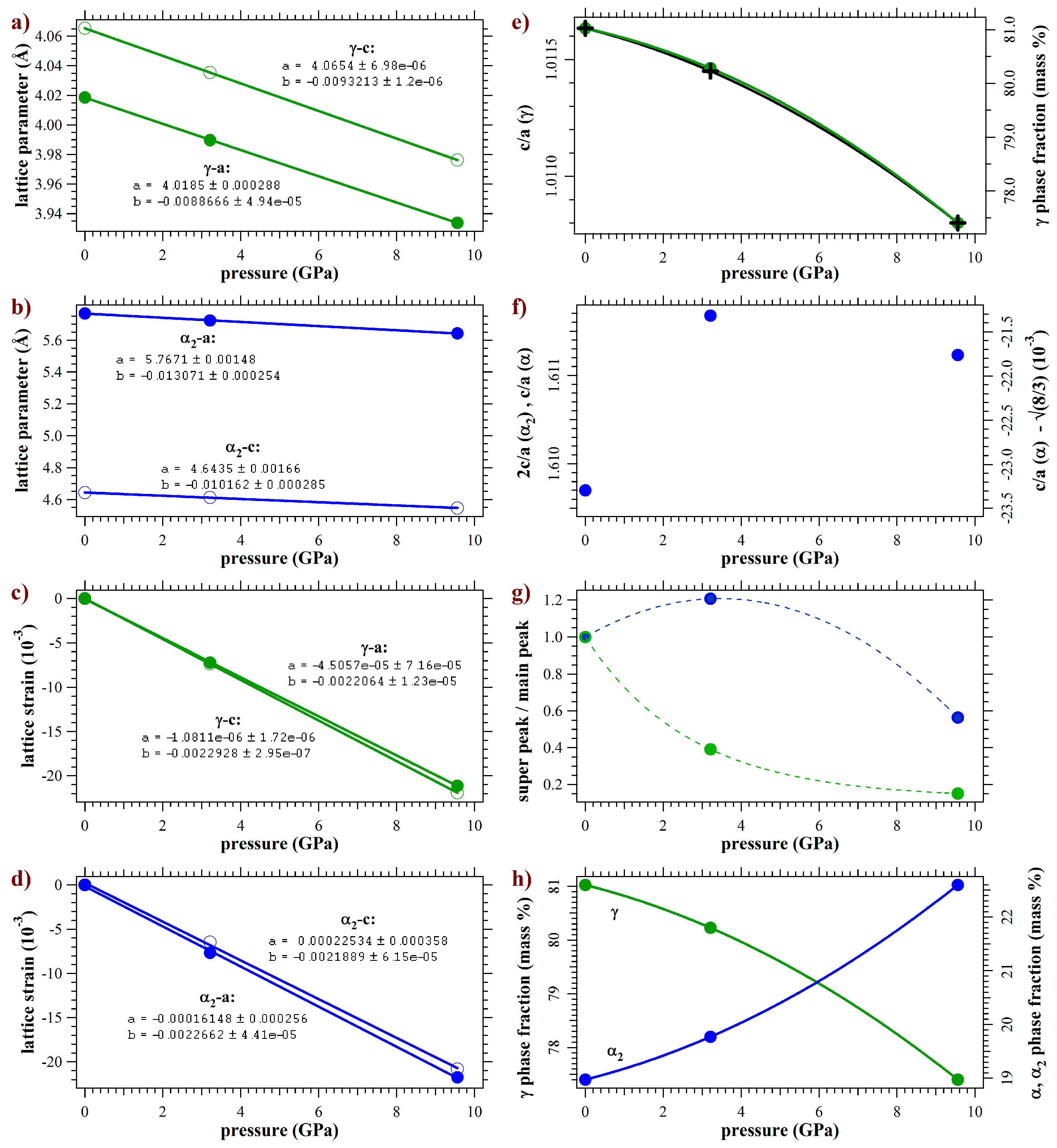
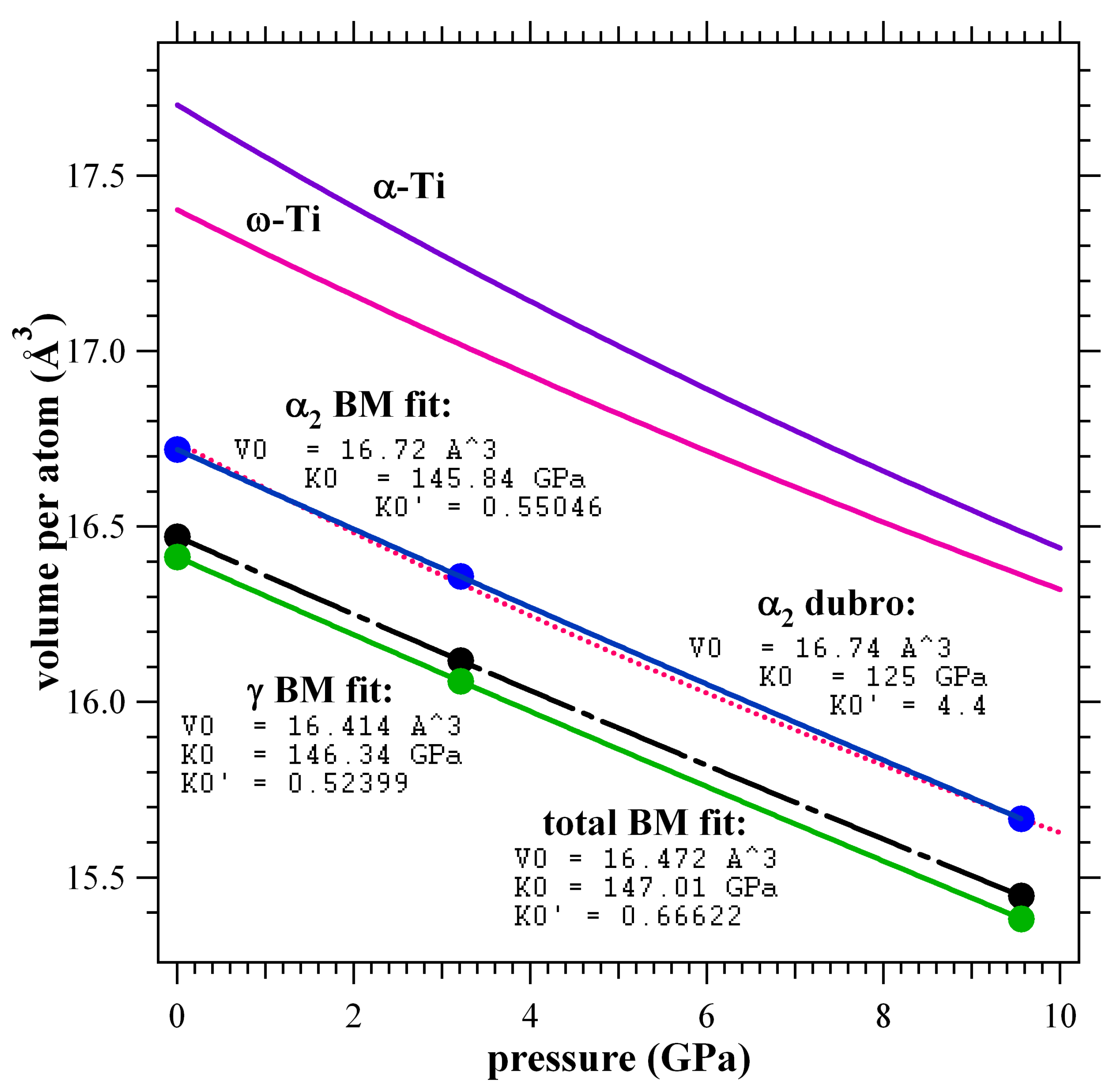
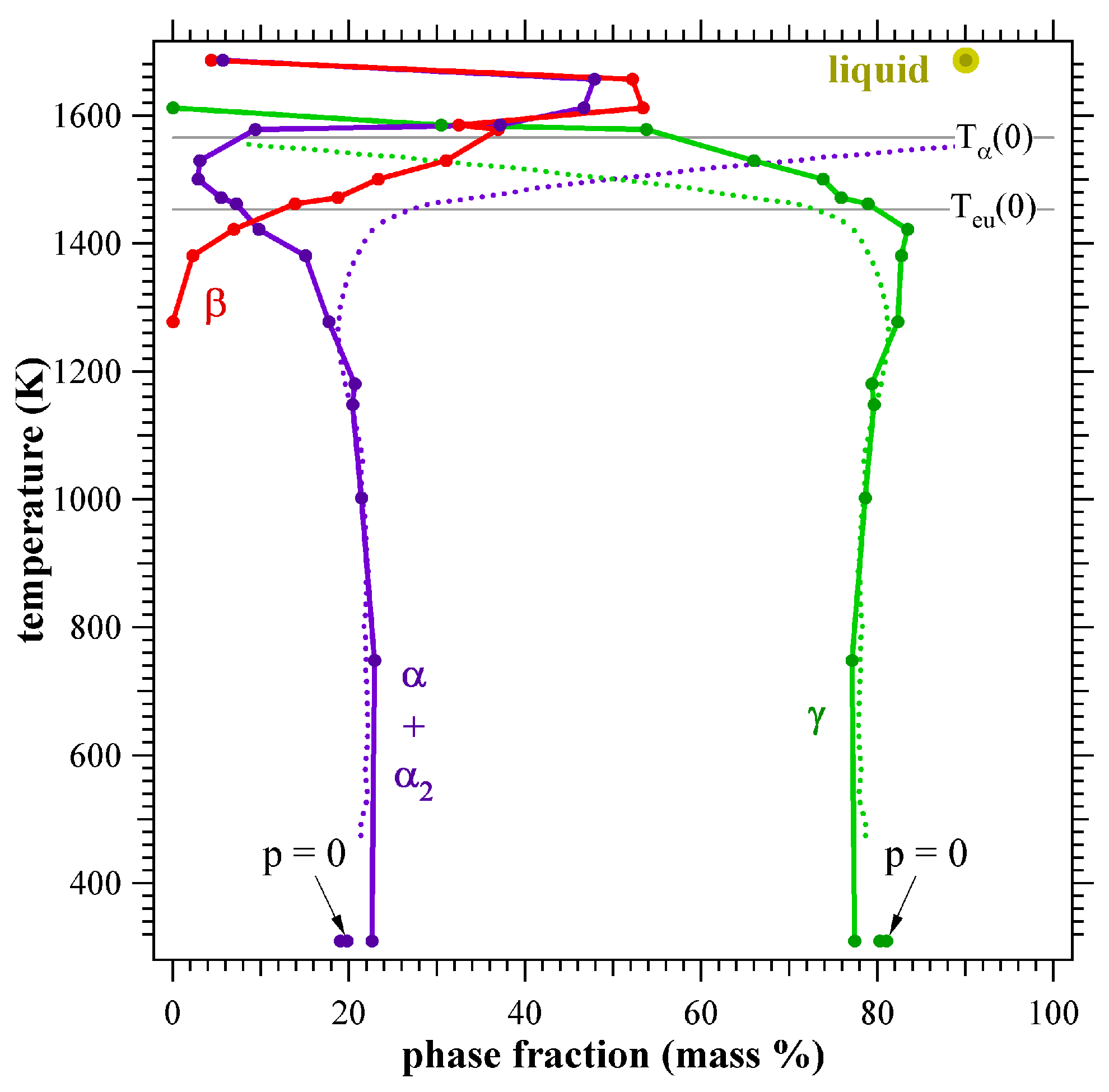

| Phase | a0 | c0 | Axis Ratio | VA | VA | K0 | K0’ | Reference |
|---|---|---|---|---|---|---|---|---|
| γ | 4.01867 | 4.06542 | 1.0116332 | 16.4138371 | 16.414 | 146.34 | 0.52399 | this work |
| α/α2 | 5.76803 | 4.64241 | 1.60970383 | 16.7201111 | 16.72 | 145.84 | 0.55046 | this work |
| total | 16.4720291 | 16.472 | 147.01 | 0.66622 | this work | |||
| α2-Ti-33.3Al | 5.7763 | 4.6348 | 1.6047643 | 16.7406041 | 16.74 | 125 | 4.4 | Dubrovinskaia |
| α2-Ti-28.4Al | 5.7829 | 4.6388 | 1.60431617 | 16.7933623 | 16.79375 | 131 | 3.6 | Dubrovinskaia |
| α2-Ti-24.0Al | 5.8083 | 4.6563 | 1.60332627 | 17.0051191 | 17.005 | 133 | 2.6 | Dubrovinskaia |
| α-Ti | 1.583 | 17.7013462 | 117 | 3.9 | Errandonea | |||
| ω-Ti | 0.609 | 17.4024491 | 138 | 3.8 | Errandonea | |||
| γ | 1.012 | 128 | Asta | |||||
| α2 | 1.698 | 126 | Asta | |||||
| γ | 3.9814 | 4.0803 | 1.02484051 | 16.1697657 | 16.181 | 112.1 | 3.91 | Ghosh |
| α2 | 5.7372 | 4.6825 | 1.63232936 | 16.6847003 | 16.584 | 111.9 | 3.83 | Ghosh |
| α-Ti | 1.5868 | 114 | 4 | Zhang | ||||
| α-Ti | 5.901 | 4.6826 | 1.58705304 | 17.651391 | JCPDS | |||
| γ-Ti-50Al | 3.9973 | 4.0809 | 1.02091412 | 16.3015706 | Menon | |||
| γ-Ti-45Al-7.5Nb-0.5C | 4.02421 | 4.07335 | 1.01221109 | 16.4912285 | Yeoh | |||
| α2-Ti-45Al-7.5Nb-0.5C | 5.77568 | 4.65646 | 1.61243698 | 16.8152283 | Yeoh |
| Ambient Pressure [29] | High Pressure: 9.6 GPa | ||||||
|---|---|---|---|---|---|---|---|
| Max γ | Eutectoid | γ-Solvus | Max γ | Min α | γ-Solvus | β Start | Solidus |
| Tγ,max (0) | Teu (0) | Tα Tγ,solv (0) | Tγ,max | Tα,min (Teu) | Tγ,solv | Tβ,start | Tm |
| 1250 K | 1453 K | 1565 K | 1420 K | 1510 K | 1590 K | 1350 K | 1660 K |
© 2016 by the authors; licensee MDPI, Basel, Switzerland. This article is an open access article distributed under the terms and conditions of the Creative Commons Attribution (CC-BY) license (http://creativecommons.org/licenses/by/4.0/).
Share and Cite
Liss, K.-D.; Funakoshi, K.-I.; Dippenaar, R.J.; Higo, Y.; Shiro, A.; Reid, M.; Suzuki, H.; Shobu, T.; Akita, K. Hydrostatic Compression Behavior and High-Pressure Stabilized β-Phase in γ-Based Titanium Aluminide Intermetallics. Metals 2016, 6, 165. https://doi.org/10.3390/met6070165
Liss K-D, Funakoshi K-I, Dippenaar RJ, Higo Y, Shiro A, Reid M, Suzuki H, Shobu T, Akita K. Hydrostatic Compression Behavior and High-Pressure Stabilized β-Phase in γ-Based Titanium Aluminide Intermetallics. Metals. 2016; 6(7):165. https://doi.org/10.3390/met6070165
Chicago/Turabian StyleLiss, Klaus-Dieter, Ken-Ichi Funakoshi, Rian Johannes Dippenaar, Yuji Higo, Ayumi Shiro, Mark Reid, Hiroshi Suzuki, Takahisa Shobu, and Koichi Akita. 2016. "Hydrostatic Compression Behavior and High-Pressure Stabilized β-Phase in γ-Based Titanium Aluminide Intermetallics" Metals 6, no. 7: 165. https://doi.org/10.3390/met6070165






